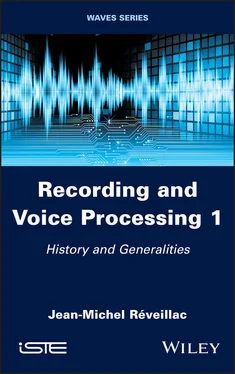1 Chapter 1Table 1.1. Some digital audio workstations (this list is far from exhaustive)
2 Chapter 3Table 3.1. Some models of dynamic moving coil microphones with their main charac...Table 3.2. Some ribbon microphone models with their main characteristics 38. For ... Table 3.3. Some condenser microphone models 39with their main characteristics (n... Table 3.4. Some models of USB microphones
3 Chapter 4Table 4.1. Major manufacturers of absorbent panels (this list is not exhaustive)Table 4.2. Major manufacturers of diffusers (this list is not exhaustive)Table 4.3. Major manufacturers of acoustic booths (this list is not exhaustive)Table 4.4. Major manufacturers of isolation shields (this list is not exhaustive...Table 4.5. Major manufacturers of pop filters (this list is not exhaustive)
4 Appendix 2Table A2.1. USB type-A and type-B pinoutTable A2.2. USB mini-A and micro-B pinout
5 Appendix 3 Table A3.1. Some compression plugins Table A3.2. Some equalization plugins Table A3.3. Some De-Esser plugins Table A3.4. Some reverb plugins
1 Conclusion
2 Appendices
3 Appendix 1. Sound Unit
4 Appendix 2. Audio Connectivity
5 Appendix 3. Audio Processing Plugins
6 Appendix 4. Tube and JFET Microphone Amplifiers
7 Appendix 5. Microphone Pairs
8 Glossary
9 References
10 Index
11 End User License Agreement
1 iii
2 iv
3 ix
4 x
5 xi
6 xii
7 xiii
8 xiv
9 xv
10 xvi
11 1
12 2
13 3
14 4
15 5
16 6
17 7
18 8
19 9
20 10
21 11
22 12
23 13
24 14
25 15
26 16
27 17
28 18
29 19
30 20
31 21
32 22
33 23
34 24
35 25
36 26
37 27
38 28
39 29
40 30
41 31
42 32
43 33
44 34
45 35
46 36
47 37
48 38
49 39
50 40
51 41
52 42
53 43
54 45
55 46
56 47
57 48
58 49
59 50
60 51
61 52
62 53
63 54
64 55
65 56
66 57
67 59
68 60
69 61
70 62
71 63
72 64
73 65
74 66
75 67
76 68
77 69
78 70
79 71
80 72
81 73
82 74
83 75
84 76
85 77
86 78
87 79
88 80
89 81
90 82
91 83
92 84
93 85
94 86
95 87
96 88
97 89
98 90
99 91
100 92
101 93
102 94
103 95
104 96
105 97
106 98
107 99
108 100
109 101
110 102
111 103
112 104
113 105
114 106
115 107
116 108
117 109
118 110
119 111
120 112
121 113
122 114
123 115
124 116
125 117
126 118
127 119
128 120
129 121
130 122
131 123
132 124
133 125
134 126
135 127
136 128
137 129
138 130
139 131
140 132
141 133
142 134
143 135
144 136
145 137
146 138
147 139
148 140
149 141
150 142
151 143
152 144
153 145
154 146
155 147
156 148
157 149
158 150
159 151
160 152
161 153
162 154
163 155
164 156
165 157
166 158
167 159
168 160
169 161
170 162
171 163
172 164
173 165
174 166
175 167
176 168
177 169
178 170
179 171
180 172
181 173
182 174
183 175
184 176
185 177
186 178
187 179
188 180
189 181
190 182
191 183
192 184
193 185
194 186
195 187
196 188
197 189
198 190
199 191
200 192
201 193
202 195
203 196
204 197
205 198
206 199
207 200
208 201
209 203
210 204
211 205
212 206
213 207
214 208
215 209
216 210
217 211
218 212
219 213
220 214
221 215
222 216
223 217
224 219
225 220
226 221
227 222
228 223
229 224
230 225
231 225
232 226
Recording and Voice Processing 1
History and Generalities
Jean-Michel Réveillac

First published 2021 in Great Britain and the United States by ISTE Ltd and John Wiley & Sons, Inc.
Apart from any fair dealing for the purposes of research or private study, or criticism or review, as permitted under the Copyright, Designs and Patents Act 1988, this publication may only be reproduced, stored or transmitted, in any form or by any means, with the prior permission in writing of the publishers, or in the case of reprographic reproduction in accordance with the terms and licenses issued by the CLA. Enquiries concerning reproduction outside these terms should be sent to the publishers at the undermentioned address:
ISTE Ltd
27-37 St George’s Road
London SW19 4EU
UK
www.iste.co.uk
John Wiley & Sons, Inc.
111 River Street
Hoboken, NJ 07030
USA
www.wiley.com
© ISTE Ltd 2021
The rights of Jean-Michel Réveillac to be identified as the author of this work have been asserted by him in accordance with the Copyright, Designs and Patents Act 1988.
Library of Congress Control Number: 2021942968
British Library Cataloguing-in-Publication Data
A CIP record for this book is available from the British Library
ISBN 978-1-78630-670-8
If you want to know if this book is for you, how it is constructed and organized, what it contains and what conventions will be used, you’ve come to the right place, this is the place to start.
This book is intended for all those who, amateur or professional, are interested in sound recording, recording and mixing in the field of singing and voice or musicians, performers, commentators and composers.
The work presented in some sections requires minimum knowledge in the field of acoustics and digital audio.
You must have a good knowledge of your computer’s operating system (paths, folders and directories, files, names, extensions, copying, moving, etc.) and know how to handle a DAW (Digital Audio Workstation), such as Avid Pro Tools, Apple Logic Pro X, Ableton Live, Steinberg Cubase, FL Studio, MOTU Digital performer, Cockos Reaper, etc., or a digital integrated studio, such as Tascam DP-03SD, Tascam DP32, Roland VS-1680, Akai DPS16HD, Yamaha AW4416, etc.
Structure and contents of the book
This work is composed of two volumes:
1) history and generalities;
2) studio work.
Volume 1 presents a preface, specifying the contents and the writing conventions used, then an introduction followed by four chapters, a conclusion and five appendices:
– recording history;
– voice;
– microphones;
– acoustic environment.
The conclusion summarizes the main topics discussed and introduces the concepts that will be addressed in the second volume.
Appendices 1–5 provide some additional information. You will find in this order:
– sound unit;
– audio connectivity;
Читать дальше













